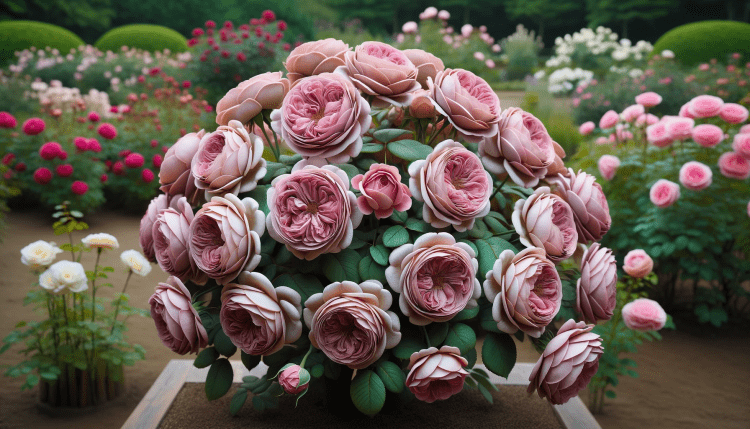
Quick Identification Guide for Roses (Genus Rosa):
Appearance:
- Roses are known for their showy, often fragrant flowers, which can come in a wide range of colors including red, pink, white, yellow, and orange.
- Flowers typically have five petals (wild species) but cultivated varieties can have many more.
- Leaves are usually pinnate, with 5 to 15 leaflets, and most species have thorns on their stems.
Common Types:
- Wild Roses: Generally have single, five-petaled flowers.
- Old Garden Roses: Includes varieties like Damasks, Albas, and Gallicas, known for their fragrance and double-flowered blooms.
- Modern Roses: Including Hybrid Teas, Floribundas, and Grandifloras, often bred for specific colors, flower forms, and longer blooming periods.
Plants Commonly Confused With:
- Camellias: Similar lush, layered petals but leaves are typically glossier, and camellias lack thorns.
- Peonies: Also have large, showy blooms, but peonies have compound leaves without thorns, and their flower form is generally more rounded and full.
- Ranunculus: Can have similar-looking blooms to certain rose varieties, but ranunculus plants are smaller and lack thorns.
Habitat:
- Roses are native to a wide range of regions across the Northern Hemisphere, from Alaska and Canada to Mexico and North Africa to Europe and East Asia.
- They grow in various habitats, from forests and meadows to mountainous regions.
Cultivation:
- Widely cultivated in gardens and nurseries worldwide.
- Prefer well-draining soil and full sun for optimal growth and flowering.
Roses are celebrated for their beauty and fragrance and have been cultivated for centuries for use in gardens, landscaping, perfumery, and as cut flowers. Their distinct flowers and growth habits, along with their cultural significance, make them one of the most recognizable and beloved plant groups.

Quick Facts About Roses
Botanical Name: Rosa spp.
Family: Rosaceae.
Origin: Roses are native to various regions across the Northern Hemisphere, with species distributed in North America, Europe, Asia, and North Africa.
Number of Species: There are over 300 species of wild roses and thousands of cultivars.
Physical Characteristics:
Flowers: Renowned for their beauty, rose flowers vary widely in color, size, and form. Wild species typically have five petals, while cultivated varieties can have numerous petals.
Foliage: Roses have pinnate leaves with multiple leaflets and serrated margins. The foliage can range from light green to dark green, and some varieties have hints of red or purple.
Thorns: Most rose species have thorns (technically prickles) on their stems, which vary in size and density.
Color Varieties: Roses come in a wide range of colors including red, pink, yellow, white, orange, and even rare shades like lavender and deep purple. Some roses are bi-colored or multi-colored.
Fragrance: Many roses are prized for their delightful fragrances, which vary from sweet and floral to spicy and musky. The scent of a rose is influenced by its genetics, soil conditions, and weather.
Growth Habits: Roses can grow as shrubs, climbers, or groundcovers, depending on the species and cultivar. Climbing roses can reach several meters in height, while some shrub roses remain compact.
Blooming Season: While wild roses typically bloom once a year, many cultivated varieties have been bred for extended blooming periods, some flowering continuously from late spring to early fall.

Historical Significance: Roses have been cultivated for thousands of years, with evidence of rose cultivation dating back to ancient civilizations like the Greeks, Romans, and Egyptians. They have been symbols of love, beauty, war, and politics throughout history.
Cultural Symbolism: The rose is a symbol of love and passion in many cultures. Different colors of roses have different meanings: red for love, white for innocence, yellow for friendship, and so on.
Uses:
- Gardening: Roses are popular in gardens and landscaping for their beauty and fragrance. They are used in borders, as hedges, and in containers.
- Cut Flowers: Roses are a staple in the floral industry, widely used in bouquets, arrangements, and as a symbol of love and affection.
- Perfumery: Rose oil, extracted from rose petals, is a valuable ingredient in perfumery.
- Culinary: Rose petals and rose hips (the fruit of the rose) are used in culinary applications, in products like rose water, jams, and herbal teas.
- Medicinal: Rose hips are high in vitamin C and have been used in traditional medicine. Rose water has anti-inflammatory properties and is used in skincare.
Cultivation: Roses prefer well-drained soil and full sunlight. They require regular watering and fertilization for optimal growth. Pruning is essential for maintaining the health and shape of the plant.
Pests and Diseases: Roses are susceptible to a variety of pests and diseases, including aphids, spider mites, black spot, and powdery mildew. Proper care and preventative measures are necessary to maintain healthy plants.
Hybridization: The modern garden roses are the result of complex hybridization processes over centuries. Breeders have developed roses for specific characteristics like color, bloom size, fragrance, and disease resistance.
Conservation: Some wild rose species are considered endangered or threatened due to habitat loss and over-collection. Conservation efforts are in place to protect these native species.
Rose Festivals: Numerous rose festivals and shows are held around the world, celebrating the beauty and diversity of roses. These events often feature garden tours, contests, and educational workshops.
World’s Favorite Flower: The rose is often referred to as the world’s favorite flower, owing to its universal appeal and presence in gardens and cultures across the globe.
Rose Gardens: Many cities and botanical gardens have dedicated rose gardens showcasing a wide variety of species and hybrids. These gardens are centers for horticultural activity, research, and education.
Record-Breaking Roses: Roses have been the subject of several world records, including the most expensive rose ever developed (‘Juliet’ by David Austin Roses, costing over $5 million in breeding) and the oldest living rose bush (believed to be over 1000 years old, located in Germany).




